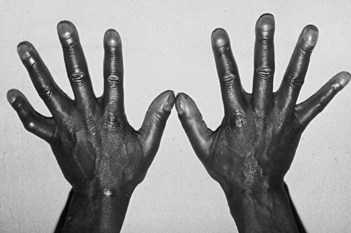136 Graves’ disease
Salient features
History
Examination
• While shaking hands with the patient note the warm sweaty palms.
• Look for tremor, thyroid acropachy (Fig. 136.1; a hypermetabolic state leading to axial bone destruction; do not confuse it with clubbing, which is usually painless), onycholysis (Plummer’s nails), vitiligo and palmar erythema.
• Check pulse for tachycardia or the irregularly irregular pulse of atrial fibrillation.
• Mention previous thyroidectomy scar if present
• Examine the neck for goitre and auscultate over the gland.
• Gynaecomastia can occur in men as a result of increased oestrogen production.
• Examine the cardiovascular system: sinus tachycardia, widened pulse pressure, loud first heart sound, third heart sound, systolic murmur, atrial fibrillation.
Questions
Advanced-level questions
What are the advantages and disadvantages of radioactive iodine compared with partial thyroidectomy for thyrotoxicosis?
What are the indications for radioiodine therapy in hyperthyroidism?
• Hyperthyroidism in Graves’ disease with moderate goitre (40–50 g), with no significant eye signs and first presentation
• Toxic multinodular goitre in older persons complicated by heart failure or atrial fibrillation
• Toxic adenoma, usually with mild hyperthyroidism
• Ophthalmopathy with thyroid dysfunction with stable eye disease (note radioiodine treatment may exacerbate eye changes in Graves’ disease and is not recommended in severe Graves’ opthalmopathy)
• Ablation therapy in those with severe manifestations such as heart failure, atrial fibrillation or psychosis.
What advice would you give to patients who are administered radioiodine?
• Depending on the dose, they should avoid journeys on public transport, stay off work, avoid places of entertainment or close contact with other people for up to 12 days and avoid non-essential close personal contact with children and pregnant women for up to 27 days.
• Patients should be warned that in the first 14 days after administration of therapy they may experience palpitations or other exacerbations of symptoms, particularly when not euthyroid before treatment.
• The importance of regular follow-up should be emphasized and the need to report the recurrence of thyrotoxic symptoms or the development of hypothyroidism.
• Patients should be informed that atrial fibrillation often reverts to normal rhythm and that digitalis may then be discontinued.
• Patients should be reminded to avoid pregnancy for 4 months after radioiodine therapy.








